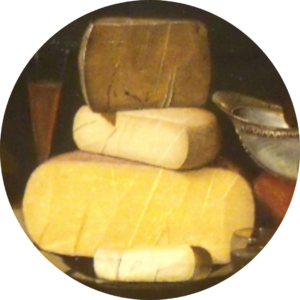Take your tasting knowledge up a step
Everyone talks taste – upfront saltiness or Roquefort, the intense savouriness of cheddar, the nutty sweetness of manchego, and flavour – nuances of straw, mushroom, broth or baby sick.
These are the first two of your three taste related senses:
- Taste in your mouth is powerful but limited (sweet, salt, savoury, acid and bitter) and senses chemicals dissolved in water
- Flavour in your nose notes compounds that are gaseous, such as herbs, fruits, dairy notes etc.
The last sense is your sense of mouth touch. It is sensed through your trigeminal nerve, which covers your face and inside your mouth and nose, and nobody talks about it. And it can provide the most powerful feedback of all.
The Role of the Trigeminal Nerve
The trigeminal nerve provides sensory input about four main factors that heavily influence tasting notes:

- Temperature: Hot and cold sensations in the mouth are perceived by the trigeminal nerve. This is why warm Brie has a different sensory profile than chilled Brie, even if the taste is identical.
- Wet or dry: the moisture level in the food or drink
- Texture: Generally what we call mouthfeel. Whether it’s creamy, gritty, or oily, it is also interpreted through this nerve.
The texture of a triple-cream cheese like Délice de Bourgogne, for instance, creates a distinct mouth-coating sensation that enriches the overall tasting experience.
- Irritation: Sensations of spiciness, pungency, and astringency—think chili heat, peppery sharpness, or the tingle of carbonation—are all managed by the trigeminal nerve. Foods and beverages with these qualities stimulate the nerve, providing additional layers of perception beyond pure flavour.
Words like the Mouthfeel of a cheese or the Body of a wine come from our Trigeminal sense.
In essence, the trigeminal nerve adds a third dimension to taste, allowing us to experience sensations that are integral to the enjoyment of food and drink.
It is the so-called Irritation category that is the most understated
Here are examples of essential descriptors that aren’t tastes or flavours, but matter very much to our experience. Scientists casually label irritants.

- Histamine: a biogenic amine, histamine produced during the fermentation and aging processes of certain foods including cheese. It doesn’t have a taste or flavour, but can produce burning, tingling, peppery or prickling sensation. Some people say it is more at the back of the mouth or throat.
- Astringency: drying and puckering sensation, sometimes called chewy or gritty.
- Bite: A loose term better understood than described. Common in older cheddars, it combines noted acidity and astringency.
- Peppery: Many cheeses, especially aged varieties like Pecorino or Parmigiano Reggiano, have a sharp, peppery kick. This isn’t purely a matter of taste but also a trigeminal response to compounds like black pepper or capsaicin in the cheese, which stimulate irritation sensors.
- Pungent: that mouth filling effect when a flavour or taste is so big and noxious in the mouth so as to be almost a physical presence.
- Spicey hot: chilli heat from peppers.
- Metallic: an impression of iron, aluminium or tin foil, sometimes found in foods high in iron or histamine. Can often feel it has a chemical interaction with your teeth or gums.

- Alcohol: Neet alcohol has a mouth filling body, often sharply warm. It makes you want to breath in sharply. At lower levels it adds body and weight to a drink of food. Low alcohol beers or wines have to compensate for the lack of body.
- Extreme acidity or salt: high slat or acid has a trigeminal effect, making the mouth and cheeks react and pucker

- Smokey: The mouth coating smoke/oil effect from notably smoked foods.
- Effervescent or fizzy: Typically from carbonization in drinks, but some foods, particularly heavily fermented foods can have a fizz to them.
- Drying: many cheeses, especially fresh goats cheeses, have a desiccating effect that seems to suck moisture from your mouth.
- Burning: many foods have high levels of irritating chemicals that it feels like your mouth is being attacked.


- Cooling and Refreshing: Soft cheeses like fresh goat’s cheese can feel cooling on the palate, especially when served chilled. This cooling sensation, while related to temperature, is also processed through the trigeminal nerve and contributes to the refreshing experience often noted in tasting descriptions.
- Creamy and Mouth-Coating: Triple-cream cheeses, such as Brillat-Savarin, leave a rich, fatty coating in the mouth. This tactile sensation, separate from the taste, provides a luxurious texture that intensifies the cheese’s richness.

- Tingling or Prickling: Blue cheeses like Roquefort may elicit a tingling sensation due to the pungent mould. This is often described as “piquant”, which I thinks makes more sense in French than English, where it seems to translate closer to spicey which does not accurately describe what one tastes. The distinctive flavours of blue mould is an area where we lack good descriptive terms.
How the Trigeminal Nerve Shapes Cheese Tasting
Cheese tasting is deeply intertwined with trigeminal sensations. A complex cheese might offer minimal taste at first but develop richness through temperature, mouthfeel, and tactile qualities as it melts and spreads across the tongue.
Consider these examples:

- Washed-Rind Cheeses (e.g., Époisses, Taleggio): Known for their strong aromas and pungent, almost stinging sensations, washed-rind cheeses stimulate the trigeminal nerve through both their smell and intense taste. The combination of ammonia-like aromas and the creamy mouthfeel creates a sensory overload that defines the experience.
- Hard, Aged cows’ milk Cheeses (e.g., cheddar, comte): astringency can come from aging. In some cheese, such as cheddar it contributes bite which for some cheese lovers is welcome. In Comte any astringency is classically a fault, and the cheese would not qualify for the necessary points to get the coveted green label.
- Hard, Aged sheep milk Cheeses (e.g., Manchego, Ossau Iraty, Pecorino Sardo): sheep cheese can pick up high levels of histamine during the aging process. For people sensitive to histamine, this can be attractive but in excess repugnant.
- Fresh Cheeses (e.g., Ricotta, Mascarpone): These cheeses are light, cool, and refreshing, but their soft, smooth texture can coat the mouth, creating a sensory impression beyond just flavour. The lightness of ricotta might feel invigorating, especially when eaten cold, offering a cooling trigeminal sensation.

Taken together with Taste and Flavour
The trigeminal nerve plays a critical role in shaping the sensory experiences associated with food and drink. When tasting many cheeses, the sensations of temperature, texture, and irritation can be as significant as the actual flavours. Cheddar without its bite or Gorgonzola Dolce without its creamy mouthfeel would not be the great cheeses they are.
By acknowledging the trigeminal sensations, we can enrich our tasting notes and deepen our appreciation for the multi-dimensional experience of cheese and wine.
Histamine, a biogenic amine, is produced during the fermentation and aging processes of certain foods, including cheese. While it doesn’t have a distinct “flavour” like sweet or salty, histamine contributes to the overall sensation of the food. It is often linked to a burning, tingling, or prickling sensation that might be noticeable in some cheeses.
What Does Histamine Taste or Feel Like?
- Burning or Tingling: Histamine can trigger sensations that feel like slight irritation, burning, or tingling in the mouth or throat. This is due to the histamine stimulating the trigeminal nerve, which responds to irritation.
- Metallic or Sharp Taste: Although histamine itself is not flavourful, some people report a sharp, almost metallic taste when consuming high-histamine foods, particularly cheeses. This sensation can blend with the natural pungency or sharpness of aged cheeses.
Histamine is often masked by other intense flavours in cheese, so it is usually felt rather than tasted in a straightforward way.
Cheeses High in Histamine
Certain types of cheese are known to contain higher levels of histamine, particularly aged or fermented varieties. The longer a cheese is aged, the more likely it is to have accumulated histamine due to bacterial activity breaking down proteins.
Here are some examples of high-histamine cheeses:
Aged Cheeses:
- Parmigiano Reggiano: This cheese undergoes extensive aging, which allows histamine to develop. The sharp, nutty taste can be accompanied by the tingly or prickly sensations associated with histamine.
- Long aged sheep cheeses, such as Pecorino Romano: Pecorino Romano has a salty, intense flavour with a peppery bite. Histamine often contributes to the slightly burning sensation some experience when tasting it.
- Gouda (Aged): As Gouda ages, its flavour intensifies, and the histamine content rises. The hard, crumbly texture can also enhance the mouthfeel, including the irritation that histamine might cause.
Blue Cheeses:
- Roquefort: This blue cheese is known for its strong, tangy, and pungent flavour. The mold used in blue cheese production can lead to elevated histamine levels, contributing to the tingling sensation felt on the palate.
- Gorgonzola: A rich, creamy blue cheese, Gorgonzola can produce similar sensations of tingling or sharpness, partly due to histamine.
Washed-Rind Cheeses:
- Époisses: Washed-rind cheeses like Époisses are notoriously high in histamine, due to the bacterial activity on the rind. This cheese has a pungent, almost stinging aroma, which can translate into a slight burning or tingly sensation on the tongue.
- Munster: Known for its strong smell and bold flavour, Munster cheese may also induce the burning, tingling feeling attributed to histamine.
Astringency refers to a dry, puckering sensation in the mouth, often associated with tannins in wine, tea, or certain fruits like unripe persimmons. In cheese, this sensation is rare but can appear due to specific factors related to the composition and aging process.
What Does Astringency Taste Like?
- Drying and Puckering Sensation: Astringency is felt as a drying or tightening effect on the mouth and gums. It doesn’t have a distinct flavour but is more of a tactile sensation caused by the binding of proteins in saliva, reducing its lubricating effect.
- Mouthfeel: The sensation of astringency can make the mouth feel rough or slightly parched. While not overly common in cheese, it can appear in certain varieties, especially those with high salt, acid, or tannin interactions from accompaniments or pairings.
Cheeses Where Astringency Might Be Noticed
Astringency isn’t a dominant characteristic in most cheeses, but there are some instances where this sensation may come into play, particularly in cheeses with specific aging processes, high salt content, or interactions with tannins from pairings. Below are the types of cheeses where you may encounter astringency.
1. Aged and Hard Cheeses
Aging concentrates proteins and reduces moisture, which can sometimes lead to an astringent mouthfeel. The salt content in these cheeses also plays a role, as it can dry out the mouth.
- Cheddar: older cheddars can have an astringent mouthfeel that is physically present and powerful
- Parmigiano Reggiano: Known for its crystallized texture and salty, umami flavour, Parmigiano may cause a slight astringency, particularly on the palate’s edges. This is more common with extra-aged varieties (over 24 months).
2. Blue Cheeses
Blue cheeses, such as Roquefort or Stilton, can sometimes induce mild astringency due to their strong, pungent flavours and interactions with blue molds. This is more of a secondary sensation compared to their creamy or salty characteristics.
- Roquefort: While more known for its salty and tangy profile, the mold in Roquefort can contribute to a slightly drying or astringent sensation on the finish, especially if paired with tannic wines.
- Gorgonzola: Similar to Roquefort, Gorgonzola may cause a minor drying or puckering sensation due to its strong flavours and interaction with mold.
3. Goat’s Milk Cheeses
Certain goat’s milk cheeses, particularly when fresh, can have an acidic tang that leads to a mild astringency. The combination of acidity and low moisture creates this effect.
- Chèvre (Fresh): Fresh chèvre often carries a clean, acidic profile that can cause a light puckering sensation. Its bright tang can create a perception of astringency, especially when paired with acidic wines or citrus fruits.
- Aged Goat Cheeses: When aged, goat cheeses such as Crottin de Chavignol can develop a stronger, more concentrated flavour that may produce slight astringency due to the interaction of acidity and drying effects from the rind.
4. Washed-Rind Cheeses
Washed-rind cheeses undergo a process that encourages bacterial growth on the rind, contributing to a strong, pungent aroma and flavour. In some cases, the rind can create a minor astringent effect, especially if consumed with the cheese.
- Taleggio: Known for its pungent aroma, Taleggio can have a hum in the mouth like mild savoury electricity.
Astringency in Pairings
Often, astringency in cheese is enhanced when paired with tannic wines like Cabernet Sauvignon, Nebbiolo, or Sangiovese. The tannins in these wines interact with the fats and proteins in the cheese, sometimes creating a more pronounced astringent sensation.
- Aged Cheddar with Red Wine: Aged cheddar paired with a tannic red wine can lead to a drying sensation on the palate, as the wine’s tannins interact with the cheese’s proteins.
- Hard Cheese with Tea: When paired with strong black teas, like Assam or Darjeeling, hard cheeses may give off more astringency due to the interaction between the tea’s tannins and the cheese’s fat content.
Take note of the astringency buzz
Astringency in cheese is not a dominant characteristic, astringency creates a tactile sensation of drying or puckering in the mouth that can add or subtract. look for it and have your own view as to whether it makes your cheese mightier or faulty.
Conclusion
Histamine doesn’t have a clear “taste” like traditional flavours, but it can manifest in sensory experiences such as tingling, burning, or even a slight metallic sharpness. Aged, fermented, and pungent cheeses—such as Parmigiano Reggiano, Roquefort, and Époisses—tend to contain higher levels of histamine, which can influence the overall tasting experience. The presence of histamine adds a unique layer to tasting notes, interacting with other strong flavours and textures to create a more complex sensation.



